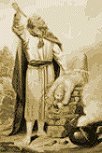|
Another tradition is that the three matzot represent the people of Israel, the priests, and the Levites, respectively. But why would the priests be depicted as "broken" in this case? Is not Jesus the "high priest of our confession" (Heb. 3:1) who provided eternal redemption by means of shedding His blood in the Holy of Holies made without hands (Heb 9:11-12; 10:11-12, 21-23)? Why would the symbolism of the broken priest be included in the Passover Seder? Did not the prophet Isaiah foretell that the Messiah would be "wounded for our transgressions," "bruised for our iniquities," and that "by His stripes we are healed" (Isaiah 53)?
The afikomen ritual has been a part of the Passover ceremony since Second Temple times, and therefore would have been part of the Passover service during the time of Yeshua. Indeed, the Greek word aphikomenos is a participle that means 'he is coming' and therefore has Messianic overtones.
Consider further that the three matzot, one of which is broken, is an image of hashilush hakodesh - the triune nature of God - with the focus on the broken middle piece of matzah, which is a picture of the suffering Mashiach Yeshua. Consider that this piece is taken, wrapped up, and carefully hidden from view, only to be discovered at the end of the Seder by little children. This is an image of the death, burial, and resurrection of Yeshua from the dead. Only after partaking of the Lamb of God who was slain for our transgressions do we understand and take hold of the reward given to those who seek for Him.
|




